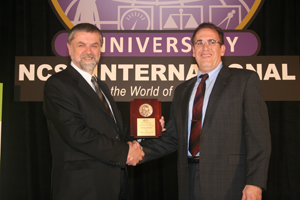Pioneering Developer of Inter-American Time Network Honored

No one can take more credit for that situation than 30 year NBS/NIST veteran Mike Lombardi, winner of the 2011 National Conference of Standards Laboratories International's Wildhack Award for "outstanding contributions to the field of metrology and measurement science."
Among other accomplishments, Lombardi pioneered development of the world's first continuous, near-real-time international time scale, which now coordinates official time among 17 national metrology institutes in North, Central, and South America through the Sistema Interamericano de Metrologia Time Network (SIMTN).
When the organization was created in 2004, only Canada, the United States, and Mexico cooperated fully in time and frequency exchange. Many other countries in the Americas lacked sufficient resources and expertise. So Lombardi developed a "black box" the size of a dormitory refrigerator that handles all data acquisition, measurements, analysis and communications, allowing laboratories with extremely limited budgets to coordinate time to an SIMTN-wide uncertainty of less than 15 ns per day, and frequency to approximately 5 Hz/100 THz (a few parts in 1014). Moreover, participants (and the general public) get results almost instantaneously via the Internet. By contrast, BIPM participating labs receive their Coordinated Universal Time (UTC) comparison information at least two weeks after their last report.

(For a description of domestic time distribution in the United States, click here.)
"The biggest challenge has been to build this network with very limited resources," Lombardi says. "There has been a tremendous amount of interest, teamwork, and creative thinking from all of the participants," many of which now have atomic clocks of their own. "Another challenge is to get more SIM members to contribute data to UTC. Years ago, I heard a history professor say that the Holy Roman Empire wasn't holy, wasn't Roman, and wasn't really an empire. Something similar could be said of UTC – it isn't completely coordinated nor is it really universal. So far, only six of the 34 national metrology institutes in the SIM region contribute data to UTC, so we need to work to get those numbers up."
Lombardi has also been active in devising novel and efficient time and frequency analysis services that allow remote customers to lock their local systems to the U.S. standard, UTC(NIST). Recently, he and a colleague published a seminal paper describing their test of a highly dependable method called the "common view disciplined oscillator" (CVDO) that makes such coordination easy. That service is now offered as NISTDO.
"I was doing some work with the U.S. Coast Guard when I proposed the idea to synchronize one of their cesium clocks in the latter part of 2008," Lombardi recalls. "We ran the experimental system throughout 2009, and submitted the paper to Review of Scientific Instruments in February 2010. We announced it as a service shortly afterwards and signed up the first customer in June 2010, just a month after the paper was published. Since then we have added a few more customers."
"The NISTDO is the most accurate distribution source for NIST time that is currently available," Lombardi says, "keeping time to within a few nanoseconds of NIST. The concept has a lot of potential that has yet to be realized, so we will continue to pursue it. The beauty of a CVDO is that the reference for the disciplined oscillator can be any time scale that makes its common-view data available. If one reference is lost, you can in theory immediately switch to another one."
Lombardi works in the Boulder labs, about 12 miles west of where he grew up. But it wasn't exactly obvious the he would work there. "As a young man, I was basically interested in everything, history, literature, writing, theology, advertising, business, science, electronics, computers, etc., and completed about 200 college credit hours in about five years, with no clear direction on what I wanted to do. I wound up with two B.S. degrees, one in advertising from the journalism school at the University of Colorado, and one in computer information systems from Regis College in Denver."
Of course, he knew about the National Bureau of Standards, "and I had first tuned in to WWV (which broadcasts time and frequency information worldwide) on shortwave when I was about 13 or 14. Still, when I started at NBS in 1981, I found it intimidating due to my lack of a strong technical background. However, I had the good fortune to work for an engineer named George Kamas who was very patient with me and showed me the ropes. He allowed me to ask as many questions as necessary – and I must have asked thousands of them.
"I was quickly hooked on metrology and have been hooked ever since. The culture at NIST has always given me the freedom to apply my various skills to the time and frequency metrology field, and it has been a rewarding career."

